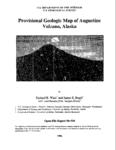Augustine Southeast Pyroclastic Fan
Start: 1470 yBP ± 160 Years [1]
Stop: 1110 yBP ± 70 Years [1]
Event Type: Explosive
- Pyroclastic flow, surge, or nuee ardente [2]
Description: From Waitt and Beget (1996): "Between about 1400 and 1100 yr B.P. (between tephra layers H and C) one debris avalanche swept to the sea on the south, another on the southwest, and perhaps a third on the north-northwest. Pumiceous pyroclastic fans were shed to the southeast and southwest and lithic pyroclastic flows and lahars(?) to the south and southeast."
"On the south-southeast coast a pumiceous pycroclastic-flow deposit (unit HCpe) is exposed only in section in lower part of the sea cliff. Farther east at southeast point a lithic pyroclastic-flow (and lahar?) deposit (unit HClc) consists of cobble gravel to sandy cobble gravel that is vaguely stratified and lacking in large boulders, suggestive of a laharic or pyroclastic-flow deposit. Upslope from Southeast Point a proximal facies (unit HClp) contains numerous angular lithic (dense) porphyritic-andesite boulders in 4-6 m range and a few as large as 9 m. Some smaller dense blocks are prismatically jointed, revealing that the flow originated as hot dome rock. Surface texture of both facies is coarsely lobate and leveed with a relatively gentle local relief as much as 2.5 m-the morphology not of debris avalanche but of lithic pyroclastic flow (or lahar?). The unusually large size of some blocks (for a pyroclastic-flow deposit) is due to the steep slope (24 degrees) and short distance (2.2 to 3.2 km) between the summit and the deposit. Both the coastal and the proximal facies are overlain by the C tephra, the coastal facies underlain by the H tephra."
"During this prehistoric period numerous domes must have been emplaced at the summit, repeatedly renewing the source for catastrophic debris avalanches. Remnants of these older domes form the east and south sides of the present summit-dome complex. Below the summit area at least three domes were emplaced on the upper flanks, one on the south (Karnishak dome), two on the northwest (domes "I" and "H"). Another undated and nearly buried dome or lava flow diversifies the upper south flank."
"On the south-southeast coast a pumiceous pycroclastic-flow deposit (unit HCpe) is exposed only in section in lower part of the sea cliff. Farther east at southeast point a lithic pyroclastic-flow (and lahar?) deposit (unit HClc) consists of cobble gravel to sandy cobble gravel that is vaguely stratified and lacking in large boulders, suggestive of a laharic or pyroclastic-flow deposit. Upslope from Southeast Point a proximal facies (unit HClp) contains numerous angular lithic (dense) porphyritic-andesite boulders in 4-6 m range and a few as large as 9 m. Some smaller dense blocks are prismatically jointed, revealing that the flow originated as hot dome rock. Surface texture of both facies is coarsely lobate and leveed with a relatively gentle local relief as much as 2.5 m-the morphology not of debris avalanche but of lithic pyroclastic flow (or lahar?). The unusually large size of some blocks (for a pyroclastic-flow deposit) is due to the steep slope (24 degrees) and short distance (2.2 to 3.2 km) between the summit and the deposit. Both the coastal and the proximal facies are overlain by the C tephra, the coastal facies underlain by the H tephra."
"During this prehistoric period numerous domes must have been emplaced at the summit, repeatedly renewing the source for catastrophic debris avalanches. Remnants of these older domes form the east and south sides of the present summit-dome complex. Below the summit area at least three domes were emplaced on the upper flanks, one on the south (Karnishak dome), two on the northwest (domes "I" and "H"). Another undated and nearly buried dome or lava flow diversifies the upper south flank."
References Cited
[1] Volcanic processes and geology of Augustine Volcano, Alaska, 2009
Waitt, R.B., and Beget, J.E., 2009, Volcanic processes and geology of Augustine Volcano, Alaska: U.S. Geological Survey Professional Paper 1762, 78 p., 2 plates, scale 1:25,000, available at http://pubs.usgs.gov/pp/1762/ .[2] Provisional geologic map of Augustine Volcano, Alaska, 1996
Waitt, R. B., and Beget, J. E., 1996, Provisional geologic map of Augustine Volcano, Alaska: U.S. Geological Survey Open-File Report 96-0516, 44 p., 1 plate, scale 1:25,000.Complete Eruption References
Provisional geologic map of Augustine Volcano, Alaska, 1996
Waitt, R. B., and Beget, J. E., 1996, Provisional geologic map of Augustine Volcano, Alaska: U.S. Geological Survey Open-File Report 96-0516, 44 p., 1 plate, scale 1:25,000.

Volcanic processes and geology of Augustine Volcano, Alaska, 2009
Waitt, R.B., and Beget, J.E., 2009, Volcanic processes and geology of Augustine Volcano, Alaska: U.S. Geological Survey Professional Paper 1762, 78 p., 2 plates, scale 1:25,000, available at http://pubs.usgs.gov/pp/1762/ .